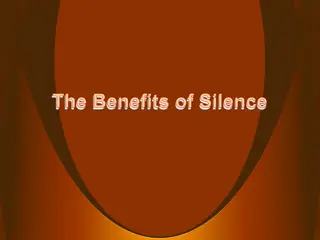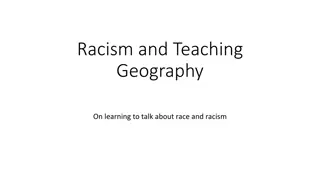Understanding Whiteness and Racism: Breaking the Silence
Delve into the exploration of whiteness as the unexamined norm and the impact of racial identity in society through discussions on racism, racial disparities, and personal growth. Examine the journey of individuals towards understanding and confronting their white identity, challenging silence around race, and committing to actionable change. Join a thought-provoking book club aiming to raise consciousness and promote systemic transformation.
Download Presentation

Please find below an Image/Link to download the presentation.
The content on the website is provided AS IS for your information and personal use only. It may not be sold, licensed, or shared on other websites without obtaining consent from the author. Download presentation by click this link. If you encounter any issues during the download, it is possible that the publisher has removed the file from their server.
E N D
Presentation Transcript
Understand history, patterns, and systems Practice talking about racism and racial disparities Personal learning and growth to create a shift within individuals Provoke an emotional state (discomfort, empathy, outrage) that raises our consciousness Commit to action and systems change The purpose of this book club
April 13th Part III: Understanding Whiteness in a White Context (Chapters 6-7) May 11th Part IV: Beyond Black and White and Breaking the Silence (Chapters 8-10)
Whiteness as the unexamined norm If you are just normal, are other people abnormal? Silence about race in white communities I m not ethnic, I m just normal
In her memoir, Waking Up White, Debby Irving recalls how she thought about her own racial identity until, at age 48, she woke up White, . Irving explains, The way I understood it, race was for other people, brown and black- skinned people. Don t get me wrong if you put a census form in my hand, I would know to check white or Caucasian. It s more that I thought all those other categories, like Asian, African American, American Indian, and Latino, were the real races. I thought white was the raceless race just plain, normal, the one against which all others were measured. Waking up White
In a race-conscious society, racial group membership has psychological implications. Messages about assumed superiority or inferiority influence our interactions with others. White people must develop a positive white identity based in reality, not on assumed superiority. White people must become aware of whiteness and its social significance, then learn to feel good about it, not in the sense of a Klan member s white pride but in the context of a commitment to a just society. White Identity Development
CONTACT: Individual adheres to the colorblind motto. They see racial difference but do not find it salientand may feel that racism is in fact propagated by the discussion and acknowledgement of race as an issue. This seemingly non-racist position can cover unconscious racist beliefs. If the individual is confronted with real-world experiences or knowledge that uncovers the privileges of white skin, they may move into the disintegration stage. DISINTEGRATION: The person has new experiences which confront his prior conception of the world. The person is often plagued by feelings of guilt and shame. These emotions of guilt and shame can be modified when the person decides to channel these emotions in a positive way but when those emotions continue to dominate, the person may move into the reintegration stage. REINTEGRATION: Marked by fear and anger toward POC in an attempt to relieve tension, guilt and shame. They may feel that although whites do have privileges, it is because they deserve them and in are in some way superior. If the person is able to combat these feelings, they maybe able to move on to the pseudo-independence stage. Helms White Racial Identity Model
PSEUDO-INDEPENDENCE: Individual does not feel that whites deserve privilege, but they look to people of color, not themselves, to confront and uncover racism. These efforts validate this person s desire to be anti-racist. The person does not have a sense of how they can be both white and anti-racist together. IMMERSION/EMERSION: The person makes a genuine attempt to connect to his/her own white identity and to be anti-racist. This stage is usually accompanied by deep concern with understanding and connecting to other whites who are or have been dealing with issues of racism. Helms White Racial Identity Model AUTONOMY: The individual has a clear understanding of and positive connection to their white racial identity. The positive feelings associated with this identity energize the person s efforts to confront racism in daily life. Alliances with POC can more easily be forged as the individual s antiracist behaviors and attitudes will be more consistently expressed.
Socioeconomic position and racial discomfort Read passage page 187
Tempting to turn away or believe opposing rhetoric. Racism is overblown White people face as much discrimination as POC POC are stealing our jobs With no tools to move forward, white people can return to what is familiar and become even more entrenched in the racial status quo. We must support each other in turning toward constructive action. Stuck in Anger/Shame/Guilt
Honor Confidentiality Small Groups Choose courage over comfort Regard feedback as a generous gesture that should always be met with gratitude
1. What stands out to you from the reading or todays presentation? 2. What did the video bring up for you? 3. Have you experienced an awakening that led to an active exploration of what it means to be white in a race-conscious society? If you are not white, have you observed/interacted with someone who is waking up white ? Discussion Questions 4. If you are white, to what degree have you experienced the identity developmental process? How can White people achieve a healthy sense of White identity in the context of a commitment to a just society? 5. What is your sphere of influence? How can it be used to interrupt the cycle of racism?























